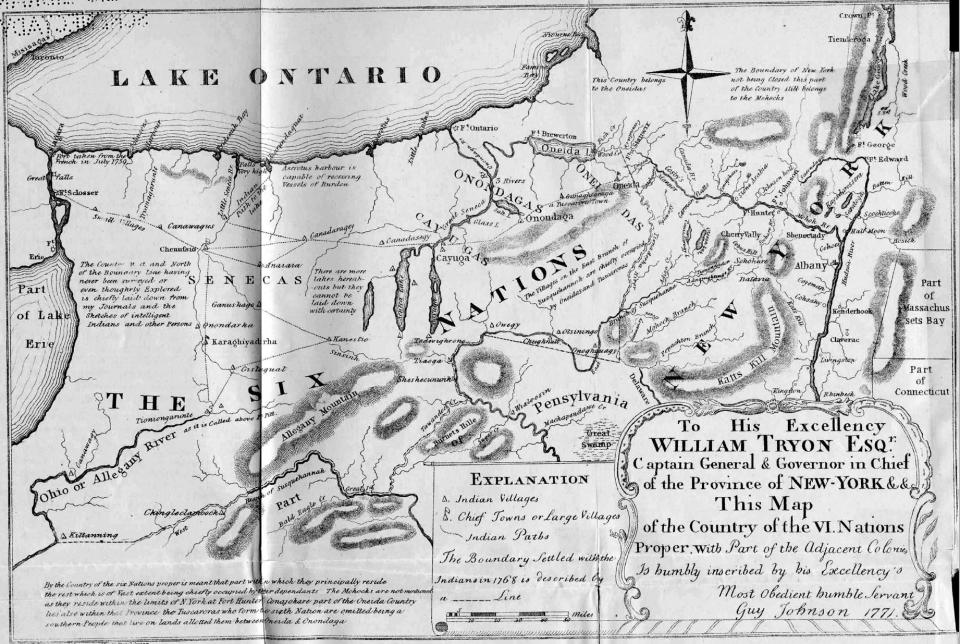Origins of local history: From Indigenous and Newtown settlements to a girl named Elmira
As the Elmira historian, I’ve always felt that our city was short-changed when we changed our name from Newtown to Elmira. Had we kept the Newtown moniker, we could have a welcome to Newtown sign that would have said settled around 1788, instead of Town of Elmira town incorporated 1808, or City of Elmira incorporated 1864. The name change cut off 76 years.
If we start from Native American history, Elmira dates to the autumn of 1730 when Red Jacket, the wise orator, sent couriers to the Five Nations and convened a council at Pine Plains (the Chemung County area), a well-known place of assembly near today’s eastern end of Water Street and Interstate 86. Elmira was then called Ka-na-we-o-la. The native village had, at one time, 20 well-built houses.
Cartographer Guy Johnson drew the first map of our area in 1771, called “Country of the Six Nations.” Chemung County was still a blank space. General John Sullivan destroyed the Indian village of Kanaweola (near today’s Kennedy Valve) in 1779. Four years later, Matthias Hollenback opened the first local trading post near today’s Clarion hotel (formerly the Holiday Inn) on East Water Street. A few settlers arrived after the 1786 Treaty of Fort Stanwix, which theoretically made our region safe for white settlers. The Iroquois were to remain in western New York. The villages of Newtown, Wisnerburg, and Dewittsburg combined into the “Village of Newtown” in 1790.

At its earliest dates, Newtown, now Elmira, had no bridges over the Chemung River. Matthias Hollenback’s trading post was the only store within 20 miles. For most of the year, a Durham boat on the Susquehanna and Chemung rivers provided the transportation for goods from his large warehouse in Wilkes-Barre. When the weather was terrible, Hollenback resorted to using packhorses. Hollenback’s store offered coffee, guns, gunpowder, brown sugar, chocolate, blankets, soap, cloth, candles, whiskey, and more. Inns and taverns served nut brown ale that kept locals and visitors happy. It was not uncommon to see Native Americans strolling down River Street. Wolves howled in the nearby hills.
According to legend, Captain Nathan Teall came to Newtown around 1794 and opened Teall’s Tavern on Sullivan Street near East Water. One of the frequent guests was State Assemblyman Judge Emmanuel Coryell, who lived somewhere between Athens and Owego. At the time, Judge Coryell was head of a committee to change the name of Newtown as there were several other Newtowns in the state.
Consumers:Behind on NY utility bills? Relief is coming. But ratepayers will eat the cost
Education:Bath school superintendent handoff will be seamless: What outgoing, incoming chiefs are saying
Groceries:Why is Wegmans carrying more of its own products, and what do customers think?
According to the Star-Gazette on June 27, 1939, “One night in 1806, little Elmira Teall, Nathan’s youngest daughter, climbed into his [Coryell’s] lap and went to sleep. Noticing her beauty, Judge Coryell thought it matched the beauty of the surrounding country and later, according to the story, asked for the Board of Trustees to change the name of Newtown to Elmira. The name Elmira is said to come from Spanish words of Moorish origin, ‘El Mira’ meaning beautiful outlook.’ Wellington’s troops took the name back to England from their Spanish campaigns, and eventually, it became the name of a character in a book. It is surmised that Mrs. Teall had read the book and named her youngest child after that character.”Our main street in the earliest times was Sullivan Street, named for General John Sullivan of the Battle of Newtown. Today’s Water Street was called River Street.
Down the road, in Chemung, New York, their sign says established 1788. Wellsburg dates to 1788. Van Etten dates to 1794. Owego dates to 1786.
The only existing reference to the name Newtown lives on as Newtown Creek, which meanders from Park Station through Chemung County where it connects with the Chemung River in Elmira.
Diane Janowski is the Elmira city historian. Her column appears monthly.
This article originally appeared on Elmira Star-Gazette: Chemung County history: Indigenous settlements to a girl named Elmira

